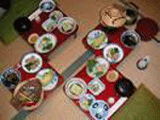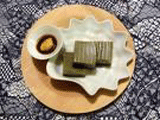 The religious practice of vegetarianism in Japan is preserved today mostly in cloistered temples. Few Japanese have eaten Zen Buddhist cooking, called shojin ryori (精進料理); fewer yet have ever cooked in this strict tradition.
The religious practice of vegetarianism in Japan is preserved today mostly in cloistered temples. Few Japanese have eaten Zen Buddhist cooking, called shojin ryori (精進料理); fewer yet have ever cooked in this strict tradition.
Shojin cooking as it has been handed down and treasured in Japan today may be credited to a great extent to the discipline of the monk Eisai (栄西). When he began the Zen sect with the establishment of Rinzai Zen in 1168, Eisai emphasized the first of the five tenets of Buddhism — “thou shall not kill” — a proscription that had been observed generally but not always applied to animals intended for slaughter. Within the Rinzai (臨濟)sect , a grand tradition of cooking and dining for religious enlightenment was born.
Shojin ryori, written with the kanji for spirit and to proceed or progress, is a direct descendant of the culinary tradition observed in early Buddhist tea ceremony. One of the most important offshoots of shojin tea-ceremony cooking, kaiseki-style(懐石) cooking, has become modern Japanese haute cuisine. Its roots are sunk in the religious practice of fasting and placing a warm stone on the stomach to stave off hunger, and it was originally written with the kanji for breast and stone. As kaiseki moved away from the religious circles in which it was developed, new characters were chosen for writing the wholly secular version to remove any shojin (庶人)connection.
Dining in the shojin style means much more than just eating. Food is approached as a vehicle, a part of a much larger daily practice that is the path to nirvana. The last of the five reflections uttered before eating — “I accept this food so that I will fulfill my task of enlightenment” — make it clear that dinnertime is for more than just partaking of physical sustenance. It is an opportunity to reflect on how the food was prepared and brought to the table and whether one is truly worthy and deserving of accepting it.
Just as vegetarian traditions in other countries reflect the variety of available foodstuffs and natural bounty, shojin ryori clearly reflects the climate, geography and topography of Japan. The two most basic flavors — the two dashi, or stocks — used in shojin cooking are made, respectively, from the bounty of the mountains and of the sea. Dashi made from dried shiitake mushrooms and stock made from konbu (giant kelp) act as the canvas for most shojin recipes
 With a canvas of light stock, the tenzo, or temple cook, uses the five methods — boiling, grilling, frying, steaming and serving raw — to present the six tastes — bitter, sour, sweet, hot, salty and delicate — in a way that will delight those partaking. In shojin cooking, there is a stark contrast between the austere — the simple morning rice gruel — and the grandiose — the many-layered feasts that are presented during festival observations.
With a canvas of light stock, the tenzo, or temple cook, uses the five methods — boiling, grilling, frying, steaming and serving raw — to present the six tastes — bitter, sour, sweet, hot, salty and delicate — in a way that will delight those partaking. In shojin cooking, there is a stark contrast between the austere — the simple morning rice gruel — and the grandiose — the many-layered feasts that are presented during festival observations.
Each of these incarnations of shojin serves a single purpose: contemplation. While preparing temple food, the tenzo and his or her apprentice — who stands beside the hearth and chants the sutra while the master cooks — focus on contemplating the task at hand.
This conscious reflection and contemplation is what really separates shojin from the laissez-faire vegetarianism practiced in the Western world today. As much as it survives as a way of cooking and dining, shojin is, at its heart, a way of life. While we may not all have the patience or commitment to devote so much energy to our food and its preparation, there is much to be learned from simple, elegant shojin ryori. At least once, take the trouble to seek out a meal of quiet and contemplation — and feed your soul.
This article is originating from The Japan Times: Sept. 2, 2001




